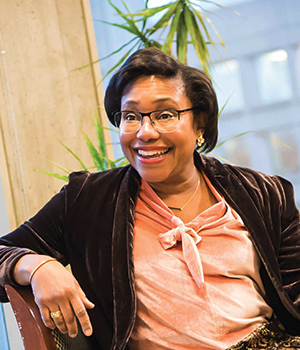
Paula Hammond
(she/her)
Chemical Engineering
Individual and departmental advancement
Paula Hammond excels at actively listening to her students, helping her students move successfully through their programs, and improving departmental systems to encourage diversity and inclusion.
Hammond is Department Head of Chemical Engineering and the David H. Koch (1962) Professor in Engineering at MIT. The Hammond Research Group at the MIT Koch Institute for Integrative Cancer Research focuses on the self-assembly of polymeric nanomaterials, including the use of electrostatics and other complementary interactions to generate multifunctional materials with highly controlled architecture. Her work has a number of electro-optical, electro-mechanical and biological applications. For cancer research, for example, the Hammond lab works on the generation of polymer-based films and nanoparticles for drug delivery.
Pushing forward
During her PhD studies, Hammond’s science was not working and she was not getting the data that she needed. “It was very frustrating and I had to reinvent my project,” she says. These sorts of obstacles, however, are not insurmountable and, just as Hammond overcame them, she leads her students to do the same. One student remarks, “When my research hit roadblocks, she helped me find new avenues to give shape to publishable stories.”
Hammond started a family during her PhD program. “What really helped me was having a group of supportive friends and faculty. Professor Michael Rubner in Material Sciences was especially understanding of the importance of family and balance.” When Hammond started her own lab, she wanted to let her students know that she understood that they have lives and that their lives required attention.
When Hammond meets with graduate students, she encourages them to talk about all issues that affect their work including research updates, home life concerns, and professional aspirations. “Because I bring up these topics, they often bring up other topics such as how to look for additional mentors, what is the best conference to go to, or how to meet the right people at the right time in one’s career.” This type of informal advising is a Mentoring Guidepost identified by the C2C program.
Whether students are struggling with qualifying exams or their research project is not producing the data they need, Hammond assures her students that it is not their fault. “I let them know that there is a path to a PhD here and we’re going to find it.” Just knowing this, sets students at ease and alleviates a lot of the stress. Hammond says, “All of these obstacles are part of the journey and everyone experiences them—we just need to get out on the other side of it.”
Diversity in the department and beyond
Hammond wants to hear what students have to say. “I’ve found that if I listen attentively enough, students begin to trust me and to share their concerns, especially about climate: whether they feel welcome or unwelcome in their environment. Then I act from there.”
Hammond also provides channels for students to express their difficulties (a Mentoring Guidepost identified by the C2C program). During a recent departmental retreat, Hammond says, “we learned that there is a gendered experience for women in our department” As Department Head, Hammond is engaging with various parties to talk about how this climate can shift into “one in which women feel equally recognized and equally able as soon as they walk in the door.”
According to C2C nominators, Hammond makes every effort to empower students from diverse backgrounds. This is perhaps best illustrated by her ongoing commitment to the MIT Summer Research Program (MSRP). By welcoming MSRP interns into her lab, Hammond gives her own graduate students valuable experiences mentoring potential future lab mates. One nominator said that their MSRP interns “spoke often about how important it was to them to be working in the Hammond Lab, and how incredibly supported they felt by Paula during their brief time with us.”
“I feel a responsibility as a woman, and as an underrepresented minority, to be visible to others… I want say, ‘there are people who look like you and have similar backgrounds to you doing this work’.”
